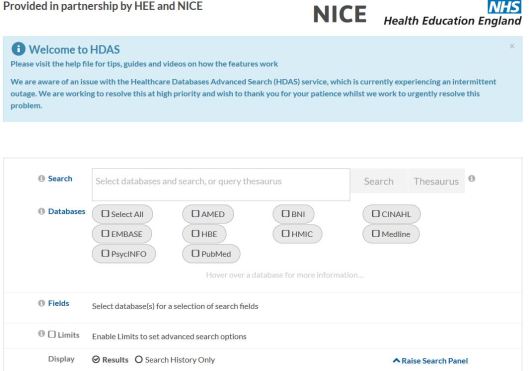This is a first in a series of posts looking at one of the most widely and frequently used search tools in the NHS in England: Healthcare Databases Advanced Search, or HDAS as it is commonly called.

HDAS is a single search interface for a collection of nine core databases provided in partnership by HEE and NICE.
The databases cover a huge range of medical and health research and published papers: from biomedicine, nursing, allied health care, psychology and psychiatry, complementary and alternative medicine, to some social services areas and hospital management and administration.
Citations on HDAS also include links to full text of articles your library subscribes to.
The databases included are:
MEDLINE (Medical Literature Analysis and Retrieval System Online, or MEDLARS Online) is likely the most important medical database. Produced by the US National Library of Medicine it contains citations from biomedical and life science journals and covers medicine, nursing, dentistry, pharmacy, allied health specialties and veterinary medicine. Database records are indexed using the Medical Subject Headings thesaurus (MeSH).
EMBASE (The Excerpta Medica dataBASE) is a major biomedical and pharmacological database. Including MEDLINE, it contains pharmacology, pharmaceutical science, clinical research, veterinary science and allied health citations. It is more European focused and one of its strong points is an extensive coverage of conference proceedings and reports. Elsevier’s Life Science thesaurus Emtree is used to index Embase .
PsycINFO is a database of abstracts of international literature in psychology and related disciplines. It includes citations from a range of disciplines such as psychiatry, education, business, medicine, nursing, pharmacology, law, linguistics and social work. All records are indexed using the Thesaurus of Psychological Index Terms.
CINAHL (Cumulative Index to Nursing and Allied Health Literature) is the go-to database for nursing, allied health professionals, biomedicine and health care. It uses the CINAHL Headings list (based on MeSH) for indexing.
BNI (British Nursing Index) is a bibliographic database covering all aspects of practice, education, and research for nurses, midwives, and health providers with a British focus. The ProQuest Thesaurus is used for indexing.
AMED (Allied and Complementary Medicine Database) is produced by the Health Care Information Service of the British Library. It covers complementary medicine, palliative care and several professions allied to medicine. AMED Thesaurus (based on MeSH) is used for indexing.
HMIC (Health Management Information Consortium database) contains information for health care administrators and managers, covering health management and services, social care, service development, and NHS organisation and administration. It combines bibliographic data from two health and social care management organisations, the Department of Health and the King’s Fund.
HBE (Health Business Elite) provides information on all aspects of health care administration and other non-clinical aspects of health care institution management including hospital management, hospital administration, marketing, human resources, computer technology, facilities management and insurance.
PubMed contains citations for biomedical literature from MEDLINE, life science journals, and online books. It covers the fields of biomedicine and health, covering portions of the life sciences, behavioural sciences, chemical sciences and bioengineering. PubMed is a free resource that is developed and maintained by the National Center for Biotechnology Information (NCBI), at the US National Library of Medicine. PubMed automatically links searches to MeSH terms and subheadings.

In HDAS you can search these databases individually, in combination with each other or across all at once. When logged in with your OpenAthens credentials you can create, store, edit and export search strategies, view, save and export search results, and set up regular updates/alerts for search strategies. Where available, search results provide a link to the full text online publications.
The next post of this series will look into the HDAS interface features.

